|
|
|
|
 Ways
To Reduce Greenhouse Gases- Start From Everyday Life
(2) Ways
To Reduce Greenhouse Gases- Start From Everyday Life
(2) |
|
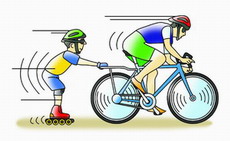 11.Walk
and Ride Bikes 11.Walk
and Ride Bikes
■If
you're only going to a store around the corner or a
local library, you should walk instead of drive. A short
trip like a shop a kilometer away can take a quarter
liter of gas. If you walk, the 20 minute trip can be
great exercise, and can save 500 grams of carbon
dioxide. If you do this 4 times, each year we can lower
carbon dioxide by 100 kilograms. |
|
 12.Use
Public Transportation 12.Use
Public Transportation
■A
single person in a car compared to public transportation
is 8 times
more
carbon dioxide per kilometer
■Take
the city bus or train to replace driving.
■For
short distances, the train or bus is more efficient than
driving.
■Carpooling
is also a good way to save energy and reduce waste gas. |
|
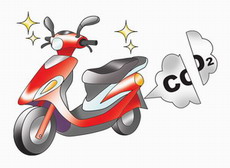 13.Buy
High Efficiency Vehicles 13.Buy
High Efficiency Vehicles
■When
you buy a new car, choose cars with higher fuel
efficiency.
■Buying
a car with a 100 km per 6 liter burning efficiency can
reduce
half
of your car's carbon dioxide emission.
■Avoid
devices that use a lot of oil, like high performance
engines,
turbine
charged V8 engines, 4 cylinder V8 engines, four-wheel
drive
gear,
clerestories, rooftop baggage racks, and air
conditioning systems. |
|
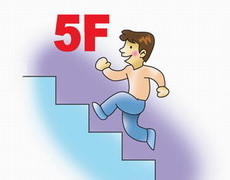 14.Climb
Stairs More 14.Climb
Stairs More
■Climb
stairs, instead of taking the elevator. Besides being
good for your health, it's good for the environment too!
Elevators are necessities in modern buildings, and many
people like taking them, to save time and energy.
However, for high electricity using elevators, to lessen
the use of them would mean saving on electricity and
conserving energy.
|
|
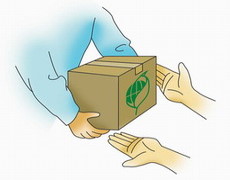 15.Buy
things with Green Label 15.Buy
things with Green Label
■As
a consumer, we can influence manufacturers with our
shopping
habits.
Avoid over packaged items and unnecessary items, and
search
for
products which harm the environment the least. By buying
long
lasting,
reusable, recyclable items, we can accomplish this.
■Buy
energy efficient office items. Buy equipment made from
recycled
materials.
When you order office items, confirm that it's made from
recycled
materials.
|
|
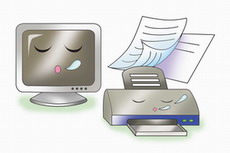 16. Turn
Off Your Computer, and Print Double-sided 16. Turn
Off Your Computer, and Print Double-sided
■When you're not
using your personal computer, turn off the power.
Don't
let your computer run all day.
■Keep
your idle printer in power saving mode. Using the
double-side
printing
function can save energy and half the paper usage!
■For
the same power types, notebook computers only use 90% of
the
energy,
lower than personal computers.
|
|
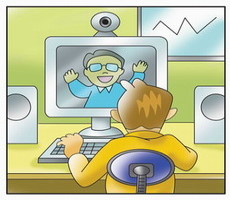 17.Use
Webcams Instead of Traveling 17.Use
Webcams Instead of Traveling
■Use
telecommunications, instead of business trips.
■Combine meetings
within the vicinity.
■Take the city
bus or trains instead of flying.
■Take the bus
instead of cabs.
■Choose hotels
close to the meeting location to avoid need for taxis.
|
|
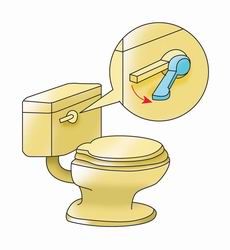 18.Use
Two Stage Flushing Toilets 18.Use
Two Stage Flushing Toilets
■Toilets
take up 40% of the regular family's water usage. If you
use a
two
stage flushing toilet, or put bricks or water bottles in
the tank of a
regular
toilet to reduce the water output, you can save about
15~40%
of
the water flushed, which will add up to 11,000~22,000
liters a year.
Another
method is to collect laundry water, dish water, and
cleaning
water
to flush toilets.
■Use unbleached
recycled toilet paper. Toilet paper may have color,
scent, print, or fluorescence, but synthesized
chemicals, dyes, and
fragrance may harm human skin.
Fluorescent compounds have a bond strongly with
proteins, and are
difficult to remove. After contact
with human skin, the combination with cuticle on the
skin produces
irritation, causing allergies and itches,
increasing the likelihood of allergic skin.
|
|
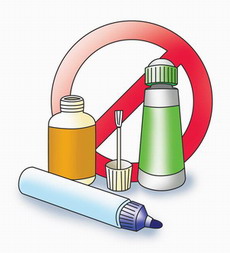 19. Avoid
Harmful Solutions 19. Avoid
Harmful Solutions
■Chemically synthesized detergents and
insecticides are toxic items used commonly in
households. Powerful chemical detergents sold in stores
usually emphasize on the ability to quickly disintegrate
oil and dust, making cleaning fast and efficient, but
this type of items usually contain strong base or acids,
surface active agents, strong corrosive agents, or
irritant toxic compounds. For the human body, this
causes eye, nose, throat, or upper respiratory
discomfort, or burns and corrosion to skin. For the
ecosystem, residual chemical compounds pass through
waste water and into the sewer system, pollution the
water and soil, and even poisoning animals and plants.
If detoxifying compounds are put in the toilet, it kills
anaerobic bacteria in the septic tank, which is bad for
decomposition. Chemical compounds are difficult to
decompose, and after long term accumulation, in
combination with the food chain, may cause even larger
harm to humans or the environment.
|
|
 20.Reuse
discarded containers 20.Reuse
discarded containers
■Discarded
plastic can be made into other useful products, for
example, bottles and glass
bottles
can be made into vases, or pen stands.
■Recycled paper
is made into pulp, then into brown paper bags or
envelopes.
■Waste cans can
be remolded into other metal products, and can be a main
source of
metal.
|
|
 Extracted
from Extracted
from
|
|
"Global Warming, What Should We Do? Read the
Prescription in the Kyoto Protocol".
Project manager: Shin
Chen Yie Illustrations by: Shu Hwai Yang Published by
the Kaoshiung City Government EPA and the Third Nature
Publishing Co. |
|
 Resource: Resource: |
|
Yue -jijo, Huang. Green
Action Handbook. Taipei Country. Environmental Bureau.
|
|
Energy Label Global Info Page
http://www.energylabel.org.tw/
Greenhouse Gas Miser Handbook
http://my.so-net.net.tw/gaia_hwang/air/ghbook/
MOEAEC Taiwan
http://www.moeaec.gov.tw
Energy and Resource Lab, Industrial Technology Research
Institute, http://www.erl.itri.org.tw
Energy Park, Taiwan
http://www.energypark.org.tw
|
|
|
|
|
|
|
|
